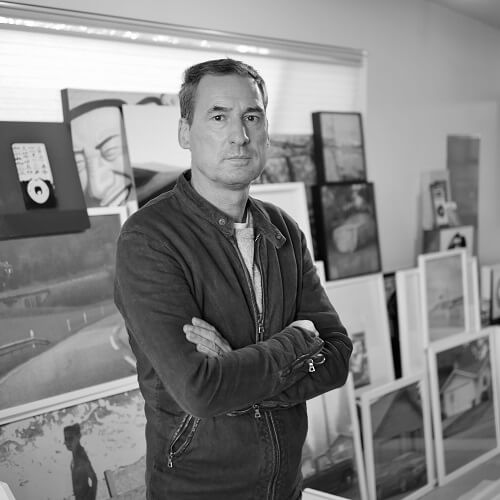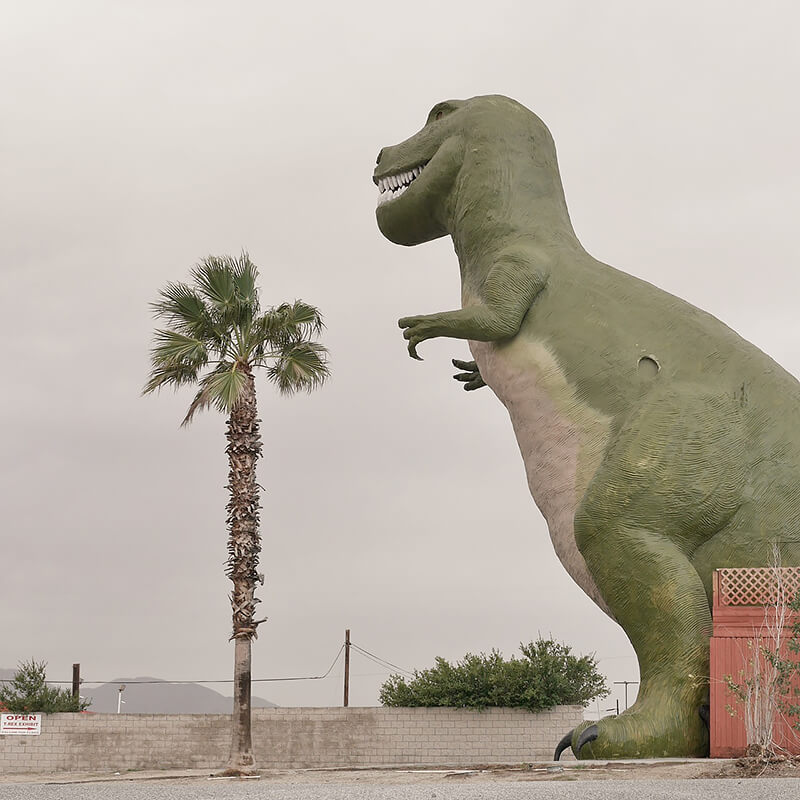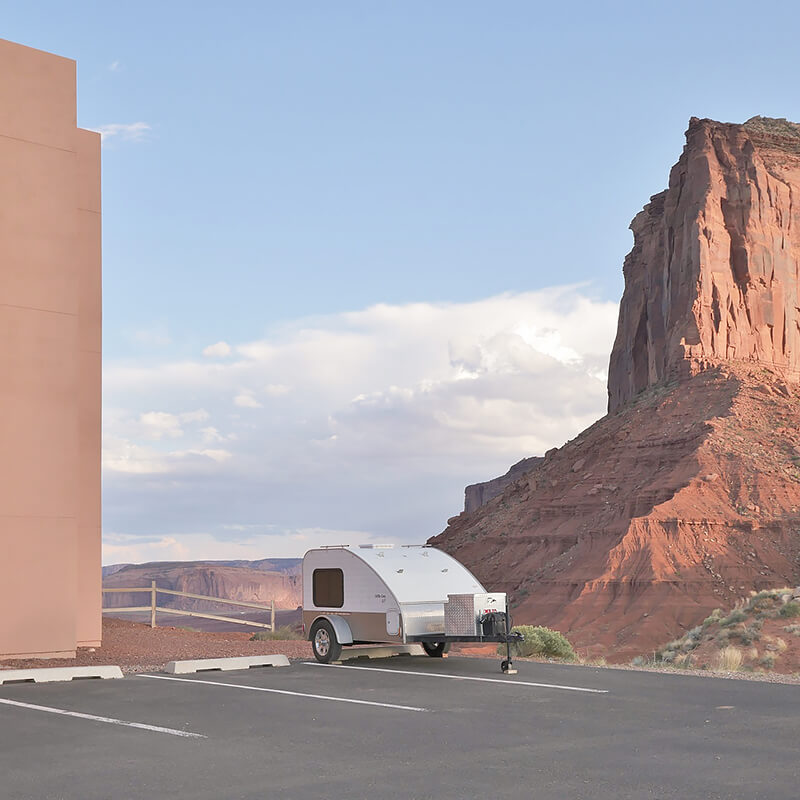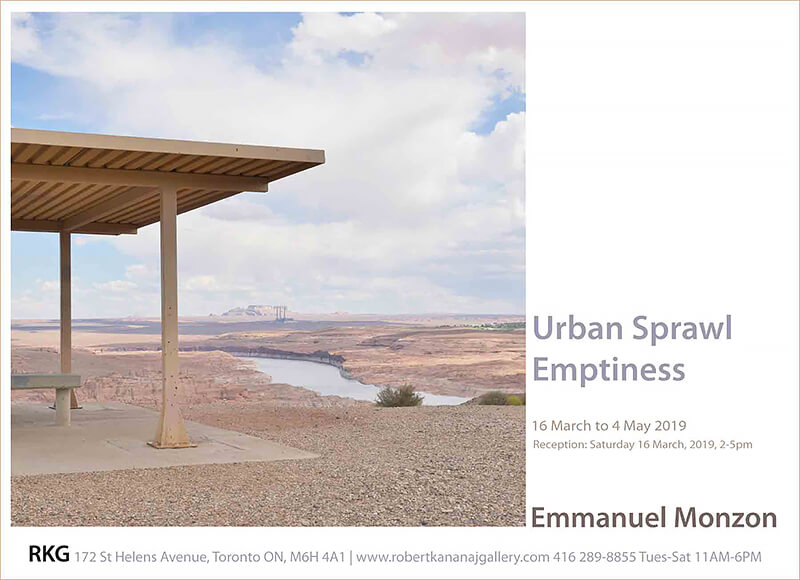Emmanuel Monzon is a talented French photographer and visual artist based in Seattle, WA. We discovered his work through
All About Photo Awards and
AAP Magazine. In his project Urban Sprawl Emptiness he photographs the
in-between state found in the American landscape. You can currently see his project at
Robert Kananaj Gallery in Toronto, CA from March 16 until May 4, 2019. We asked him a few questions about his life and work:
All About Photo: Tell us about your first introduction to photography?
Emmanuel Monzon: As a trained plastic artist (I graduated from the Beaux-Arts in Paris), I have always worked with images and the stakes of its representation. I've always been fascinated by images, be they from photography, cinema, advertising, TV shows. However I started with painting (specializing in drawings and pastel colors). For a long time, I reproduced in drawing 'poor' photography from catalogs, leaflets, with zero aesthetical aspects, at real scale and I have a lot of it. My approach to photography comes from this time, which is linked to questioning an image, its representation, its reproduction, its broadcasting. Anecdotally, toward the end of this period, I ended up exhibiting large scale photography of my own urban landscape drawings on tracing paper.
About ten years ago, I felt the need to use the medium of photography. In practice, I always see myself as a painter who uses the tool of photography as a transitional passage. I'm in the in-between, I'm a photographer who paints or a painter who uses photography.
AAP: When did you start working on Urban Sprawl Emptiness?
Emmanuel Monzon: As soon as I arrived in Seattle, I had the intuition that my work had to continue through the medium of photography, it was obvious to me. I had the feeling that my work could only be photographic for this space, which creates its own mythology. One understands very quickly that one is going to be on perpetual move on this territory; Somehow I became nomadic and the only tool I need is a camera. I also quickly realized that I was going to live in my own subject and that it was a privilege.
This generic title, Urban Sprawl Emptiness, was imposed by the seriality and the repetition of my subjects of predilections: the deserts of the American West and their poetic and chaotic processions of motorway interchanges, the cities without centers, the residential zones without inhabitants. I have the feeling that the extension, the identical and omnipresent reproduction of the trace of the humans on this territory, ultimately shrinks the world.
I believe that the expansion of the urban or industrial landscape in the American natural landscape has redefined this space and has become itself a non-place. The transition from one site to the next: You have arrived and at the same time you have never left.
AAP: Why did you choose a square format?
Emmanuel Monzon: The square is above all the rigor almost ascetic.
This framing guides and defines my line of work, it is a choice of voluntary restriction, which obliges me not to return entirely in the codes of the photograph, and limits my field of action in a deliberate way. It allows me to focus on the subject, to put it at a distance, to create a soft tension. Symbolically I find that the square format sends back an image of stability, solidity, and neutrality, it wants to be objective. This format forces me to make choices, to be more rigorous. In a way, it creates boundaries to my field of action. The square symbolizes the stop, or moment taken, an idea of stagnation of solidification. It is the perfect balance, and imposes its structure on my images, and puts order in my composition.
This rigor I also apply to my selection during my solo show for urban sprawl emptiness series, it is a drastic selection, and few pieces are exposed.
AAP: When did you move to the USA and why?
Emmanuel Monzon: After leaving Paris in 2006, I lived in Asia for seven years before moving to the US. I moved to Seattle almost NINE years go. We moved here with our two boys because my wife had a job opportunity.
AAP: Do you consider yourself a tourist, an immigrant in the US?
Emmanuel Monzon: At the beginning, I truly felt like an immigrant, but, little by little, I felt in-between both, split between the here and there at the same time. I am present here without being here.
AAP: How long did you travel for that project or how many trips did you do? How do you prepare for your trips?
Emmanuel Monzon: Usually, my travels last between 4 and 8 days, and 5 to 6 times during the year whether they are planned or not.
I plan my road-trips, checking google and building my itineraries. I usually travel either with my family or with friends, knowing I need someone to drive so I can spot the places I want to shoot.
Below is the process I usually go through:
I drive around a lot.
I like to circle around the subject, map it.
I can stay a long time in a specific place and shoot it thoroughly multiple times.
Sometimes the frame is obvious, but not always. I know that the subject is there but I cannot really see it so I shoot obsessively hoping to find a result when back at my studio.
I can also come back to the same place many times.
Then, back to the studio.
AAP: What equipment do you use?
Emmanuel Monzon: My go to camera is simply a PANASONIC LUMIX DMC GX8, I just changed the lens to a LEICA DG SUMMILUX 25MM and the LEICA 35-100, Olympus 12-100mn. I need to have it handy, ready to shoot. I don't have sentimental attachment to my camera, I only hope for efficiency.
AAP: Do you spend a lot of time editing your work?
Emmanuel Monzon: Still the same ritual to know about:
a. I sort out the images
b. I extract my storyline
c. I do the first step of framing (always using square frames)
d. I choose the color that will stand out for the series
e. I let the series rest for several days
f. I go back to it, repeating the same process from a to e
Lately, I don't discard the leftovers, I re-work them several months later and sometimes I can find new directions. As I said before, I am using the same process as a painter. I think first about the sketch, the draft. Then, I work my picture like a painting on a canvas, I select the colors. Throughout this process, a series emerge, articulated around its own story, its place, its mood
AAP: What advice would you give someone who would like to become a photographer today?
Emmanuel Monzon: It is a bit difficult for me because I don't define myself as a real photographer. The use of photography is just a transition, a way for another interpretation of the real thinking of it as a painter. I am not looking for a photographic result, I conceptualize it more like a piece or a painting; I have stayed in the world of painting and visual art.
But to answer your question, the real question a photographer should ask him/herself, is whether the picture you're taking is worth it or not.
AAP: What mistake should a young photographer avoid?
Emmanuel Monzon: To not to avoid mistakes! On the contrary, it is an obligatory way into photography, the construction of an approach is built on past mistakes. Especially in the domain of photography, where it is easy to be impressed by your own result.
AAP: Your best memory as a photographer?
Emmanuel Monzon: My first successful photo from « Urban Sprawl Emptiness » was the day of joyful realization for me. I realized that I would be going on a very long voyage with this exiting sensation to have so much more to do in the future.
AAP: Your worst souvenir as a photographer?
Emmanuel Monzon: Not really any bad souvenirs, but recurrent things such as the suspicion of certain people towards me when I shoot; a lot of questions, often suspicious, a little aggressive, for example: Why do you photograph this house? This car? This road? This place? Because there is no interest to do so. Some follow me a few minutes, some call the police. We are in the realm of the Neighborhood Watch and apparently, a camera seems more dangerous than a gun.
AAP: What are your upcoming projects?
Emmanuel Monzon: I have just finished preparing a solo show that will present a series of 20 pieces for a Canadian Gallery (RKG Gallery-Toronto, Exhibition from the 16th of March to the 4th of May), and I am very excited to be part of this exhibition.
AAP: Anything else you would like to share?
Emmanuel Monzon: Just my mantra: I stop and look for some form of poetic beauty. I like repetitions, I like series, and I like driving around.
All about the exhibition:
Urban Sprawl: Emptiness, Emmanuel Monzon Photographs
16 March - 4 May, 2019
Robert Kananaj Gallery is honoured to bring to the Toronto public an opportunity to experience the photographs of Emmanuel Monzon. When so much is invested in what is loud and in your face, Monzon's Urban Sprawl series finds an opposing refuge in emptiness and silence. The artist invites one's experience, conversing in a no-man's land bordering the collision of cultures.
...I capture places of transition, borders, passages from one world to another. Am I leaving a city or entering a new environment?... If I could sum up the common theme of my photos, it would be about emptiness, silence. - Emmanuel Monzon
This solo exhibition at Robert Kananaj Gallery of photographs by Emmanuel Monzon, is his first in Canada.
Emmanuel Monzon is a photographer and visual artist based in Seattle, WA. He graduated from the Academy of Beaux-Arts in Paris, France with honours. His work has been featured throughout the US, Europe and Asia through exhibitions, selections and various awards. Through his work, he explores and questions the signs of urban sprawl in our visual field. His photographic process is influenced by his background in the plastic arts.
Emmanuel Monzon at Robert Kananaj Gallery
by Cary Benbow
The work of Emmanuel Monzon embodies an approach of capturing the aesthetic of the banal, and grasping the everyday scene in such a way as to render it both an image and a screen for the projection of wishes and fantasies in the intermediate zone between urban and rural America. The uneasy emptiness found there results in an independent identity.
Monzon's work falls into a space bordered traditionally and contemporarily by Giorgio de Chirico, Edward Hopper, Richard Misrach, and Michael Kenna. Formal aspects of Monzon's images echo aspects of rendering the inanimate and the animate in a play of light and shadow, forms and patterns. Monzon's animate elements are blatantly absent, but nonetheless, this deliberate strategy is hauntingly reminiscent of their cropping, use of foreground and concentration on visual elements which Monzon uses to make a comment on urban sprawl, and the twenty-first century tension experienced between occupied and unoccupied spaces. Kenna and Misrach both deal with the subject of landscape and explore the effects of human interaction and isolation. Their visions are achieved through long exposures, or expansive vistas, but Monzon chooses to take the baton of simplicity and clarity, and drive away with it. His automotive wanderings spur meaningful photographs in his response to the land. His quiet studies of shape, form, pattern, signage and landscape are a respite amidst the uneasy 'non-places', which he associates to the expansion of the urban or industrial landscape in the American natural landscape.
Monzon chose to photograph the in-between state found in the American landscape. He captures places of transition. A visual segue which gives the traveller an enigma. The limbo caught by his lens holds the viewer in check, and begs the question: am I leaving someplace or entering another? The disconcerting environment inspires him. The emptiness in both the urban landscape, and in the great American spaces. He mixes two approaches: The codes of the new topographics and the concept of 'in-between two states' as inspired by the anthropologist Marc Auge. These transitional non-places are like intersections or passages from one world to another, such as going from a residential area to an industrial area. Monzon includes views of tourist locations which are altered by human influence. We often find a feeling of emptiness, of visual paradox when encountering these spaces when traveling throughout the United States. By displaying structures humans built to serve their own needs, but in a rare state of absolute idleness, he creates a disconcerting environment. The visual irony of the significant impact of people upon their surrounding environment, and their notable absence in his images results in an eerie, surreal tension that stops viewers in their tracks.




